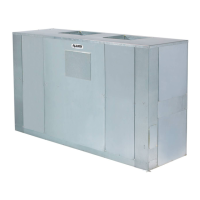Page 104
C3 or C5 DIAGRAM WITH D5 DIAGRAM
Flexstat or Prostat with Modulating Economizer
3-C3 or C5 Section with D5 Section
An EMDH16M or REMD16M economizer may be applied to a GCS16 with Flexstat or Prostat.
Both are programmable thermostats which allow GCS16 units to automatically setback or set
up setpoints for unoccupied periods as well as control setpoints more precisely than electro
mechanical thermostat. With the economizer added, the Flexstat and Prostat are capable of
directly controlling the operation of outdoor air dampers.
NOTE - In order to understand how these optional controls affect the operation of the GCS16,
you must first understand how all GCS16 components work. Refer to the operation se
quence for basic unit operation.
NOTE - These thermostats have a built-in clock for controlling setback. Optional time clock
CMC3-1, night thermostat and night relay kit are not needed and are not compatible.
No wiring is required when connecting an economizer. Economizer plug P4 connects to
GCS16 jack J3 in the unit blower compartment. Jumper-plug P3 is removed and discarded.
See figure 92. Refer to Table 23 for thermostat terminal designations.
IMPORTANT - Flexstat model L2F has been superseded by Flexstat L2F-N. Terminal desig
nation on the two controls are different. This sequence of operation describes models L2F-N.
Refer to Table 24 for more information.
Operation Sequence:
1- Economizer outdoor air dampers drive full closed anytime blower B6 is not operating.
2- The Flexstat and Prostat are designed so that the fan switch in the thermostat is to be left in the
ON mode at all times. This allows the blower to be controlled by terminal G inside the Prostat (4
in Flexstat). The blower operates continuously during occupied periods and intermittently
(only during demand) during unoccupied periods.
NOTE - Flexstats ONLY: If slide switch number 7 on back of model L2F-N (slide switch num
ber 5 on back of L2F) is switched to ON position, the blower operates continuously during
occupied periods and automatically cycles during unoccupied periods. If this slide switch is
switched to OFF position, the blower operates normally during unoccupied periods, con
trolled by the ON/AUTO button on the face of the control.
3- During a heating demand when the building is not occupied, the blower is activated only when
a heating demand passes through relay K25 in the GCS16. During a cooling demand when the
building is not occupied, the blower is activated through terminal G in the Prostat (4 in Flex
stat).
4- Setback relay K11 (not furnished) is not used in this application. Contacts K11-1 and K11-2 (if
installed) are normally closed and should remain closed at all times.
Heating Demand:
5- Heating demand (Prostat terminal W1 - Flexstat terminal 2) activates the GCS16 heating sec
tion directly.
6- Additional heating demand (Prostat terminal W2 - Flexstat terminal 3) is not used in this ap
plication.
7- Economizer outdoor air dampers remain at the minimum position allowed by the minimum
positioner during blower operation.
Cooling Demand Enthalpy Low:
8- Enthalpy control internal relays switch to close a circuit from 1k terminal 1 to 6 and from 2K
terminal 3 to 5.
9- Cooling demand (Prostat terminal Y1 - Flexstat terminal 5) is routed through enthalpy control
terminal 1 to energize internal relay 1S. Contacts 1S1 close to energize damper motor. Out
door air dampers open to provide 1st stage cooling.
10- Economizer outdoor air dampers drive full open during blower B3 operation (anytime there is a
cooling demand)to provide 1st stage cooling. Outdoor air dampers drive full closed anytime
blower B3 is not operating.
11- Additional cooling demand (Prostat terminal Y2 - Flexstat terminal 7) is routed through enthal
py control terminals 1 and 2 and through terminal 5 to energize the compressor. The compres
sor provides all additional cooling.
Cooling Demand Enthalpy High:
12- Enthalpy control internal relays switch to close a circuit from 1k terminal 1 to 2 and from 2K
terminal 3 to 4. Internal relay 1S is de-energized and contacts 1S1 open. Outdoor air dampers
close. Dampers open to minimum position during blower B3 operation.
13- Cooling demand (Prostat terminal Y1 - Flexstat terminal 5) is routed through enthalpy control
terminals 1 and 2 and terminal 5 to energize the compressor. The compressor handles all cool
ing demand.
14- Blower demand (Prostat terminal G - Flexstat terminal 4)energizes blower relay K3 in the unit.
Contacts K3-1 close to energize the blower and contacts K3-2 close to energize the econo
mizer. When 24VAC is applied between damper motor terminals TR and TR1, the outdoor air
dampers open to minimum position. Dampers remain open when blower B3 is operating and
close when B3 is not operating.
15- Increased cooling demand (Prostat terminal Y2 - Flexstat terminal 7) is not used in this ap
plication.

